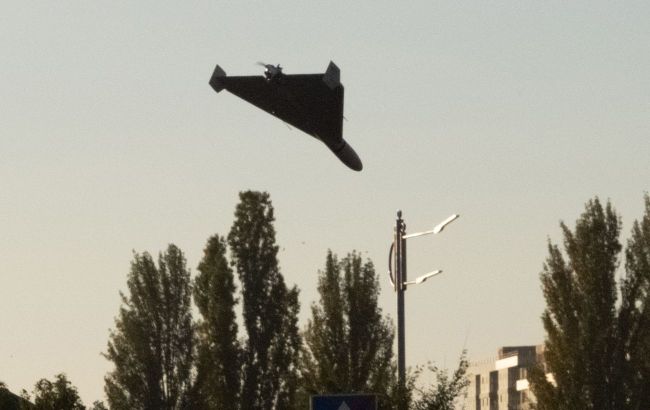Shaheds in Belarus and Tu-95 takeoffs: Russia's plans and possible consequences
 Illustrative photo (Getty Images)
Illustrative photo (Getty Images)
Russia shows no signs of abandoning its air terror tactics against Ukraine, using both drones and missiles. Recently, however, attacks involving Shahed drones have seen UAVs wandering into Belarusian territory, while the presence of Tu-95MS bombers in the air doesn't always indicate impending missile launches.
All about Russia's plans and the potential consequences of the aggressor's actions in the RBC-Ukraine analysis below.
Contents
Reason behind Shahed drones entering Belarus?
Starting from July 11, during Russian attacks involving Shahed drones, these UAVs have repeatedly entered Belarusian territory from Ukraine. As of yesterday evening, July 16, there were four such instances, with two occurring just yesterday. Some kamikaze drones, wandering over Belarus (sometimes for hours and covering hundreds of kilometers), eventually returned to Ukrainian airspace, while others disappeared within Belarus. During these flights, Belarusian aviation was involved in three out of the four cases.
The monitoring channel Belaruski Hayun suggests that Belarusian military forces might have been aware of the Russian maneuvers and deployed helicopters or fighter jets to timely destroy the drone if it malfunctioned.
RBC-Ukraine asked military expert Pavlo Narozhnyy what might be behind such "wanderings" of kamikaze drones into Belarus. He says that the theories about possible reasons border on conspiracy theories. Nonetheless, he names several probable scenarios that the enemy might be pursuing.
"First, it could be data collection. Essentially, Shaheds are quite large and can carry a significant payload - up to 50 kg. It could be a radar or anything else, theoretically. So the drone could gather some data, fly to Belarus, and the data could be retrieved there," Narozhnyy speculates.
According to him, another possible reason could be to provoke the Ukrainian air defense system to shoot down the drone.
"Or, for instance, they might observe if our radar activates and then target that radar. The Russians have the Kh-31P anti-radiation missile. A third possibility is that it could be due to our Ukrainian electronic warfare systems, which might either jam the drone's GPS signal or send fake signals, causing it to fly in a random direction," Narozhnyy explains.
The fourth option, in his view, could be an attempt by Russia to provoke Belarus.
"Imagine a Shahed flies to the Mozyr oil refinery or lands on its territory, causing a fire. Russia or Belarus could then accuse us, claiming it was a Ukrainian drone strike. This could be a casus belli (a reason for war) for Belarus," the expert says, adding that there is currently no public evidence to support any of these theories, so they remain speculative.
Why Russia frequently deploys Tu-95MS bombers
Another noteworthy behavior of the enemy is the increased activity of its Tu-95MS bombers (potential carriers of Kh-101 cruise missiles) in the sky recently. For instance, Russia recently deployed strategic aviation from the Olenya airbase in the Murmansk region. Only one Tu-95MS was involved, apparently in a "training flight." Recently, these enemy aircraft performed a launch maneuver, but it was later revealed that the launches were simulated. Although there wasn't a direct attack, the Ukrainian Air Force still warns of potential danger and readiness to respond. Moreover, after a massive attack on July 8 (when the aggressor hit the Okhmatdyt children's hospital in Kyiv), the enemy used these bombers for strikes, albeit infrequently.
Military expert Pavlo Narozhnyy believes that there isn't a single objective behind the actions of the Russian Air Force, as there are many components to consider.
"It could be aircraft training or testing after repairs, or indeed actions to keep the Ukrainian population on edge. They understand very well that we will notice these takeoffs, and there will be air raid alerts," the interlocutor says.
He recalled the example of the MiG-31K fighter, which the Russians almost daily deploy into the air, causing the air raid alert map to turn red. According to him, this is a very similar story to the Tu-95MS flights, which occur without missile launches.
"Why don't they always launch missiles? Because conducting such a large-scale attack involving dozens of cruise missiles is quite a complex logistical task. There are many problems, and it depends on the base from which the aircraft takes off. But overall, deploying these dozens of missiles involves dozens of railway cars traveling across Russia, loading/unloading, heading to a base, etc. Therefore, they often cannot conduct such attacks frequently. For example, doing it once a week is unlikely, but they might carry out a more substantial missile attack every 15-20 days," the expert adds.
The last time Russian forces used strategic aviation for a large-scale attack on Ukraine was on July 8. On that occasion, Putin's army launched missiles at Kyiv, Dnipro, Kryvyi Rih, Sloviansk, and Kramatorsk. Notably, the Okhmatdyt children's hospital in the capital was hit. Overall, dozens of people died in Kyiv and other cities due to this shelling, and nearly two hundred were injured. RBC-Ukraine covered the tragedy in detail in a separate article.
Sources: data from the Telegram channel of the Ukrainian Air Force, the monitoring channel Belaruski Hayun, and exclusive comments from military expert Pavlo Narozhnyy.

